Ivan Butakov
FMMI: Flow Matching Mutual Information Estimation
Nov 11, 2025
Abstract:We introduce a novel Mutual Information (MI) estimator that fundamentally reframes the discriminative approach. Instead of training a classifier to discriminate between joint and marginal distributions, we learn a normalizing flow that transforms one into the other. This technique produces a computationally efficient and precise MI estimate that scales well to high dimensions and across a wide range of ground-truth MI values.
Curse of Slicing: Why Sliced Mutual Information is a Deceptive Measure of Statistical Dependence
Jun 04, 2025Abstract:Sliced Mutual Information (SMI) is widely used as a scalable alternative to mutual information for measuring non-linear statistical dependence. Despite its advantages, such as faster convergence, robustness to high dimensionality, and nullification only under statistical independence, we demonstrate that SMI is highly susceptible to data manipulation and exhibits counterintuitive behavior. Through extensive benchmarking and theoretical analysis, we show that SMI saturates easily, fails to detect increases in statistical dependence (even under linear transformations designed to enhance the extraction of information), prioritizes redundancy over informative content, and in some cases, performs worse than simpler dependence measures like the correlation coefficient.
InfoBridge: Mutual Information estimation via Bridge Matching
Feb 03, 2025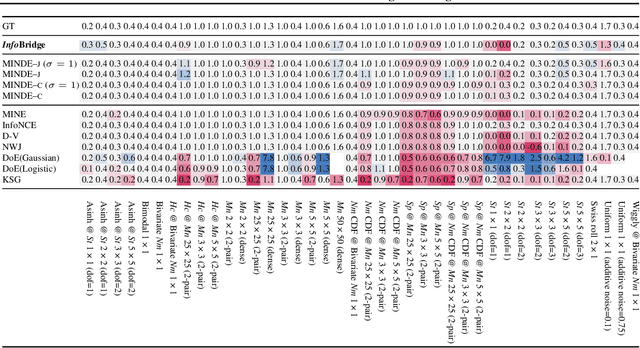
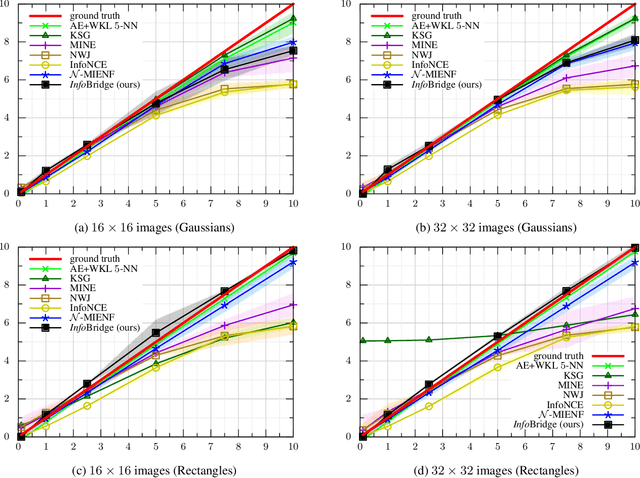
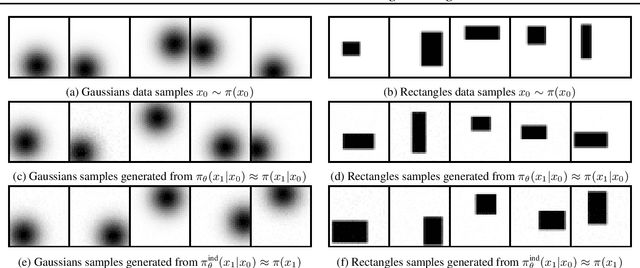

Abstract:Diffusion bridge models have recently become a powerful tool in the field of generative modeling. In this work, we leverage their power to address another important problem in machine learning and information theory - the estimation of the mutual information (MI) between two random variables. We show that by using the theory of diffusion bridges, one can construct an unbiased estimator for data posing difficulties for conventional MI estimators. We showcase the performance of our estimator on a series of standard MI estimation benchmarks.
Efficient Distribution Matching of Representations via Noise-Injected Deep InfoMax
Oct 09, 2024
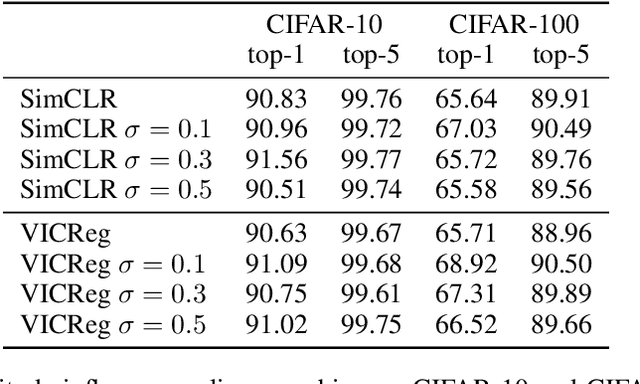


Abstract:Deep InfoMax (DIM) is a well-established method for self-supervised representation learning (SSRL) based on maximization of the mutual information between the input and the output of a deep neural network encoder. Despite the DIM and contrastive SSRL in general being well-explored, the task of learning representations conforming to a specific distribution (i.e., distribution matching, DM) is still under-addressed. Motivated by the importance of DM to several downstream tasks (including generative modeling, disentanglement, outliers detection and other), we enhance DIM to enable automatic matching of learned representations to a selected prior distribution. To achieve this, we propose injecting an independent noise into the normalized outputs of the encoder, while keeping the same InfoMax training objective. We show that such modification allows for learning uniformly and normally distributed representations, as well as representations of other absolutely continuous distributions. Our approach is tested on various downstream tasks. The results indicate a moderate trade-off between the performance on the downstream tasks and quality of DM.
Mutual Information Estimation via Normalizing Flows
Mar 05, 2024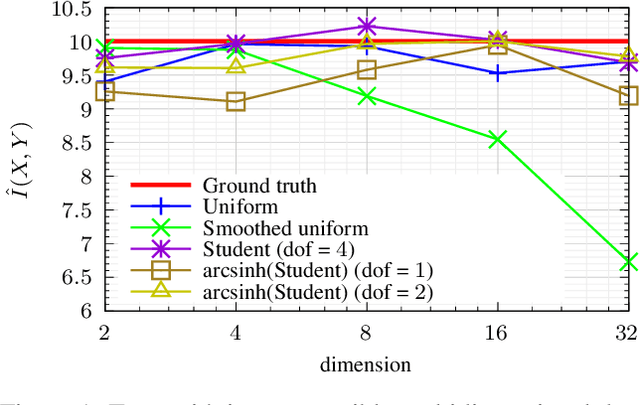

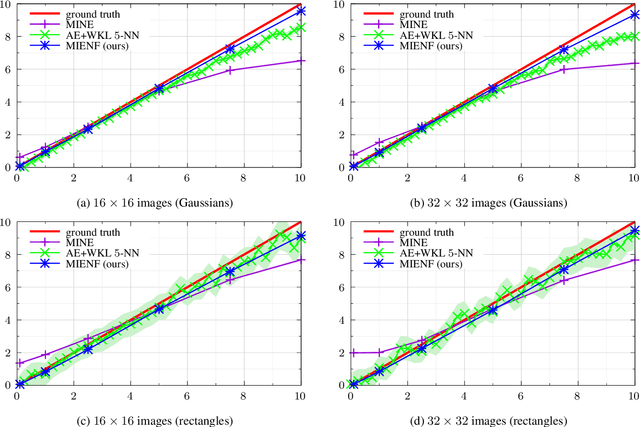
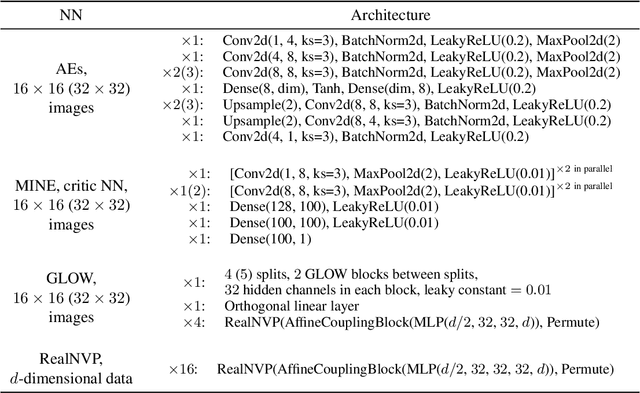
Abstract:We propose a novel approach to the problem of mutual information (MI) estimation via introducing normalizing flows-based estimator. The estimator maps original data to the target distribution with known closed-form expression for MI. We demonstrate that our approach yields MI estimates for the original data. Experiments with high-dimensional data are provided to show the advantages of the proposed estimator.
Information Bottleneck Analysis of Deep Neural Networks via Lossy Compression
May 13, 2023Abstract:The Information Bottleneck (IB) principle offers an information-theoretic framework for analyzing the training process of deep neural networks (DNNs). Its essence lies in tracking the dynamics of two mutual information (MI) values: one between the hidden layer and the class label, and the other between the hidden layer and the DNN input. According to the hypothesis put forth by Shwartz-Ziv and Tishby (2017), the training process consists of two distinct phases: fitting and compression. The latter phase is believed to account for the good generalization performance exhibited by DNNs. Due to the challenging nature of estimating MI between high-dimensional random vectors, this hypothesis has only been verified for toy NNs or specific types of NNs, such as quantized NNs and dropout NNs. In this paper, we introduce a comprehensive framework for conducting IB analysis of general NNs. Our approach leverages the stochastic NN method proposed by Goldfeld et al. (2019) and incorporates a compression step to overcome the obstacles associated with high dimensionality. In other words, we estimate the MI between the compressed representations of high-dimensional random vectors. The proposed method is supported by both theoretical and practical justifications. Notably, we demonstrate the accuracy of our estimator through synthetic experiments featuring predefined MI values. Finally, we perform IB analysis on a close-to-real-scale convolutional DNN, which reveals new features of the MI dynamics.
 Add to Chrome
Add to Chrome Add to Firefox
Add to Firefox Add to Edge
Add to Edge